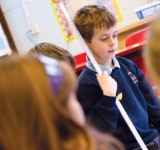If children use well worn techniques to solve problems without understanding or modelling the context, their maths skills won't fully evolve
Children, from birth, are proficient problem solvers. By the age of two or three they have solved what are probably life’s two biggest problems - how to walk and how to talk. As they get older they solve practical problems, such as sharing a bag of sweets fairly with others, long before they’ve heard of division. In this article, I look at how we can build on this natural propensity to solve problems in teaching mathematics.
Routine problems are problems children know how to solve based on their previous experiences. The sort of thinking required by routine problems can be described as reproductive: the child only needs to recall or reproduce a procedure or method they have previously learnt. A problem like ‘Apples’, for example (see below), is likely to be a routine problem for most children at the upper end of primary school; they know to multiply the two numbers together without having to think deeply about what operation to use.
Apples
• Apples on a supermarket shelf are in bags of eight.
• If Jane buys six bags, how many apples is that?
In contrast, non-routine problems are where the learner does not immediately have a solution tucked under his belt. The problem solver has to put some effort into understanding the problem and creating, rather than recalling, a solution strategy. Non-routine problems engage learners in productive thinking.
We often think of non-routine problems as needing to be unusual or not having, to us as adults, an immediately obvious method of solution. ‘Stamps’ is typical of this type of non-routine problem.
Stamps
• Clearing out a desk draw I found a collection of 5p and 6p stamps.
• I have a parcel to post that needs 58p worth of stamps on it.
• Can I create this exactly using the stamps I found?
• If so, is there more than one way of doing this?
 ‘Stamps’ is fairly obviously non-routine for almost anyone encountering it. But ‘Apples’ would be a non-routine problem for, say, a six-year-old who had not done much work on multiplication. Whether or not a problem is routine or non-routine does not simply lie in its formulation; it also depends on whether or not the problem solver has had extensive experience of that type of problem. What might seem like an obviously routine problem to adults can be treated as a non-routine problem with younger learners.
‘Stamps’ is fairly obviously non-routine for almost anyone encountering it. But ‘Apples’ would be a non-routine problem for, say, a six-year-old who had not done much work on multiplication. Whether or not a problem is routine or non-routine does not simply lie in its formulation; it also depends on whether or not the problem solver has had extensive experience of that type of problem. What might seem like an obviously routine problem to adults can be treated as a non-routine problem with younger learners.
In choosing problems to work with, we need to decide whether or not we think a problem will be routine or non-routine for the particular children working on it. In the rest of this article, the problems chosen are being treated as though they are non-routine problems for the children working on them. That’s not to say that I don’t think routine problems have a place in the curriculum - they do. Here, however, I want to deal with some of the issues around teaching and learning non-routine problems.
Pizzas
• Four hungry girls share three pizzas equally.
• Eight hungry boys share six pizzas equally.
• Does each girl get more pizza than each boy, less or the same?
 Traditionally, ‘Pizzas’ is a routine problem given to children after they have done work on fractions and division with the expectation that they quickly recognise each girl gets 3/4 of a pizza, each boy gets 6/8 of a pizza, which is equivalent to 3/4, and so they each get the same. Next question.
Traditionally, ‘Pizzas’ is a routine problem given to children after they have done work on fractions and division with the expectation that they quickly recognise each girl gets 3/4 of a pizza, each boy gets 6/8 of a pizza, which is equivalent to 3/4, and so they each get the same. Next question.
As a routine problem, the ‘story’ of pizzas and hungry children doesn’t serve any real purpose: children quickly learn to disregard the context, to strip out the mathematics and to work some procedure. The problem could just as easily have been put in the context of builders sharing bricks and many learners would happily say each builder would get 3/4 of a brick, without stopping to question the near impossibility of sharing out bricks.
We can, however, treat ‘Pizzas’ as a non-routine problem and use it to introduce children to thinking about fractions and equivalences. The context of hungry children and pizzas then becomes important. It is not chosen simply to be window-dressing for a fraction calculation. Nor are pizzas chosen because children are intrinsically motivated by food, making the unpalatable topic of fractions digestible. No, the context s chosen because children know about fair shares and slicing up pizzas - they can solve this problem without any formal knowledge of fractions. As the researcher Terezhina Nunes once pointed out, young children would not be able to solve the ‘bald’ calculation 3 divided by 4 but, “show me four young children who, given three bars of chocolate to share out fairly, hand the bars back saying ‘it can’t be done.”
Children have ‘action schemas’ for solving problem like ‘Pizzas’ - they can find ways to solve this with objects, pictures, diagrams and, eventually, symbols. Teaching can then build on the children’s informal solutions to draw out the formal mathematics of fractions. From being one of 20 ‘problems’ on a worksheet to complete in a lesson, ‘Pizzas’ can become a ‘rich task’ taking up the best part of a lesson, if children work on it in pairs and carefully selected solutions are then shared with the class.
Part of the productive thinking in working on rich, non-routine problems requires children to create mathematical models, and we can teach to support this.
Milk
• At the supermarket Myprice, milk costs £1.08 per litre.
• This is 7 pence less per litre than milk costs at Locost.
• How much does 5 litres of milk cost at Locost?
 Children who treat ‘Milk’ as a routine problem won’t fully engage with the context or meaning. They will focus on the numbers involved and look for ‘keywords’ they think will tell them what operation to use. When the quantities £1.08 and 7 pence are followed by the word ‘less’, these children think this means they have to subtract and so they take 7 pence away from £1.08 to get £1.01. Then the words ‘how much’ and ‘5 litres’ suggest that £1.01 should be multiplied by five, giving £5.05 as the answer.
Children who treat ‘Milk’ as a routine problem won’t fully engage with the context or meaning. They will focus on the numbers involved and look for ‘keywords’ they think will tell them what operation to use. When the quantities £1.08 and 7 pence are followed by the word ‘less’, these children think this means they have to subtract and so they take 7 pence away from £1.08 to get £1.01. Then the words ‘how much’ and ‘5 litres’ suggest that £1.01 should be multiplied by five, giving £5.05 as the answer.
What is missing from this approach is attention to setting up an appropriate model of the problem. Ultimately this could be a mental model of the problem context, but it helps initially to encourage children to put something on paper that can be shared and discussed. In problems involving quantities, like ‘Milk’, simple bar diagrams can help children create the appropriate model. These help children examine the relationships between the quantities (as opposed to simply fixing on specific numbers and keywords).
Setting up a diagrammatic model begins with creating a representation of what is known in the situation. In this example, we know milk at Myprice costs £1.08, so a diagram for this would look like:
MYPRICE £1.08
This provides the basis for talking about what the picture for the price of milk at Locost is going to be. Will the bar be longer or shorter? Where is the bar for the 7 pence to be drawn?
Two different models can be set up and children asked to describe the relationship between the prices at the two supermarkets, to see which diagram fits with the information in the problem. If the diagram for the price at Locost is shorter by 7, then two statements can be made:
MYPRICE £1.08p
LOCOST 7p
• Myprice milk costs 7 pence more than milk at Locost.
• Locost milk costs 7 pence less than milk at Myprice.
In comparison, making the bar for milk at Locost longer by 7 gives different comparative statements:
MYPRICE £1.08p 7p
LOCOST
• Myprice milk costs 7 pence less than milk at Locost.
• Locost milk costs 7 pence more than milk at Myprice.
Children can then talk about which of these situations fits with the wording in the problem.
Having established that Locost milk must be £1.15 a litre, children can go on to produce the bar diagram model for this.
 Solving non-routine problems is harder than working through routine ones, just as facing a blank canvas is more challenging than colouring in. When children are working through non-routine problems, we have to acknowledge the difficulty and the anxiety that can be provoked. Unfortunately, a lot of the research in mathematics education shows that the difficulties and tensions in non-routine problem solving are often alleviated by teaching that turns the non-routine into routine. One big study, for example, tracked 58 non-routine problems as they were played out in classrooms: only 22 of them continued to be treated as nonroutine throughout the lesson1. Reasons researchers identified as contributing to the ‘decline’ of non-routine problems included too much emphasis on getting the correct answer (at the cost of the problem solving processes) and reducing the level of challenge to implementing a known procedure.
Solving non-routine problems is harder than working through routine ones, just as facing a blank canvas is more challenging than colouring in. When children are working through non-routine problems, we have to acknowledge the difficulty and the anxiety that can be provoked. Unfortunately, a lot of the research in mathematics education shows that the difficulties and tensions in non-routine problem solving are often alleviated by teaching that turns the non-routine into routine. One big study, for example, tracked 58 non-routine problems as they were played out in classrooms: only 22 of them continued to be treated as nonroutine throughout the lesson1. Reasons researchers identified as contributing to the ‘decline’ of non-routine problems included too much emphasis on getting the correct answer (at the cost of the problem solving processes) and reducing the level of challenge to implementing a known procedure.
Where the problems were played out as non-routine, three factors identified are worth noting. First, in choosing the tasks, the teachers made sure they would build on learners’ prior knowledge - as I suggest a problem like ‘Pizzas’ can. Second, in contrast to focusing on getting the answer, the researchers observed what they called ‘sustained pressure for explanation and meaning’. In other words, the teachers pressed for children to explain what and why they were doing what they were doing rather than simply focusing on whether or not they had got the correct answer. Third, the amount of time children were allowed to work on the problem was neither too long or too short: children need enough time to ‘get into’ a problem, but too much time can lead to a loss of engagement.
Gather together a collection of problems covering all the years of education in your school (or ask teachers to each contribute two or three problems).
Working together in small groups, teachers sort the problems into three groups:
1. Problems they think would be routine for the children they teach
2. Problems they think would be non-routine for their children
3. Problems they think would be much too difficult for their age group
Everyone agrees to try out a problem from group 2 with their class. Discuss how too much focus on getting the answer can reduce the challenge and stress the importance of pressing children to explain their working. At a subsequent meeting, people report back, focusing in particular on strategies they used to keep the problem solving non-routine.
Mike Askew is Professor of Primary Education at Monash University, Melbourne. Until recently, he was Professor of Mathematics Education at King’s College, University and Director of BEAM.
Should you let educational researchers into your classroom?
Ace-Classroom-Support
Supporting parents with maths
Ace-Maths
Boosting children’s self esteem
Ace-Classroom-Support
